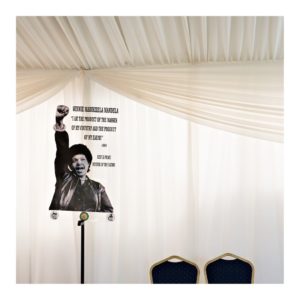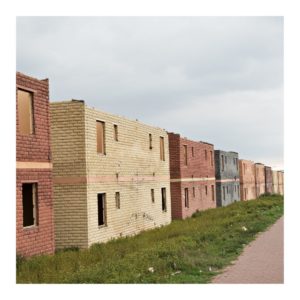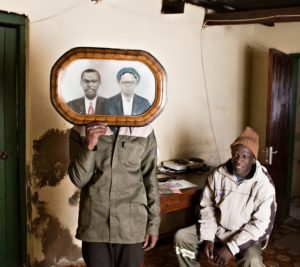
Dhlamini utilised the concept of time as historic through the fleeting moment of the camera lens to examine social ills in contemporary South Africa.
The South African critic Themba Tsotsi on the photographer Jabulani Dhlamini
Kwa Qawekazi Orlando West, 2018
Jabulani Dhlamini: iXesha
On History and Time
The Goodman Gallery hosted South African photographer Jabulami Dhlamini in an exhibition titled iXesha. Dhlamini is one of the emerging and prominent young documentary photographers in South Africa having participated in Five Photographers: A Tribute to David Goldblatt at the French Institute, he was also published in Aperture magazine’s 2017 summer issue. The show incorporated works from the artist’s oeuvre in an effect that subsumed nostalgia about a country in transformation and an artist who is coming to terms with his documentary photography as part of a conversation about heritage. Dhlamini utilised the concept of time as historic through the fleeting moment of the camera lens to examine social ills in contemporary South Africa.
*
This was Dhlamini’s third exhibition with the gallery and it saw an artist coming to terms with not just a growing reputation, but it was as an exhibition from an artist who has to come to terms with being a master of his craft. Having received praise from the likes of David Goldblatt and having participated, as I said, in a tribute exhibition to the late master titled Five Photographers, A Tribute to David Goldblat, the Goodman Gallery draws a parallel between the photographers that is tantamount to a national and historic conversation.

Dube Hostel, Soweto, 2018
Ixesha is a vernacular word that translates into English as time, the significance of which is an exploration of Dhlamini’s themes about subjects that affect the collective psyche of the community he emanates from. With the recent passing of the struggle stalwart Winnie Madikizela Mandela, the collection titled iQhawekazi which translates to English to ‘heroine’ Dhlamini highlights the plight of the community, like Goldblatt was not afraid to make connections between what is private and public in economically disadvantaged contexts. This is reflected in the piece titled Dube Hostel, a piece that captures the skeletal structures of housing tenements under construction. The skeletal structures being symbolic of the unified struggles between what is private and public. The piece also articulates the tenuous nature of the psychological impact of neglected social ills.

Taba Dimahlong, Mzimlhophe Soweto, 2018
Dhlamini in this collection was concerned with the present, its conception coinciding with the passing of one of the most important contributors to the struggle to end oppression in South Africa, was able to articulate the resulting opacity or lack of clarity between the past and what has to happen in order true change to be reflected in the community. The piece titled Taba Dimahlong, Mzimlhophe Soweto captures this historic opacity. A close up of a house through a rain wet window articulates the measure of lack of clarity with the connotations of depravity, poverty and an uncertain inheritance from the past that imbues the piece with an equal measure of lack and uncertainty about the future. Dhlamini has captured the door on the corner of the house from this angle the image pronounces transience and a stability of conditions.

Mkhulu Makomu, Zenzeleni, in Warden, 2016
The iQhawekazi collection was also published in the Financial Times magazine in April this year, in a conversation about an international conversation in feature in which Dhlamini was the only African artist. In contrast to the political connotations of the iQhawekazi collection, the Recapture series documents the privation of private space in intimate and choreographed strategy that incorporated the past in a measure that makes it immediate. The piece titled Mkhulu Makomu, Zenzeleni, in Warden two male figures one sitting, the other holding a portrait of the houshold’s couple covering his face. The statement about deliberate anonymity that history imposes on the present, becomes in the intimate context of a home a conversation about the emergency in a country in the process of transformation. The piece articulated the measure of dignity of township life in contrast to the macrocosm of national transformation. In the context of the various collections from Dhlamini’s oeuvre in this exhibitions this image assumed a poignancy that is transparent and imbued with the vulnerability that Black males are subjected to by history.

On our way to FNB Stadium for Mandela’s Memorial Service from JHB, Soweto, 2013
This exhibition has incorporated works from as far back as 2013, with images as recent as 2018. Most striking is an image titled On our way to FNB Stadium for Mandela’s Memorial Service from JHB, Soweto. Consistent with the poignant moment of Winnie Madikizela’s Mandela’s passing, this image was comprised of hands inside a train gripping safety straps. This image also resounds with the tenuous implications of a country loosing an important leader, like the image inspired by the passing of Mandela’s former wife, this image was imbued with the poignancy of a present left to its own devises, yes there is a measure of inheritance, but it was still imbued with the sense of isolated individuality that the past subjected the community to. The image was captured in the anonymous arena of a public transport, this pronounced the measure of individuality that David Goldblatt’s work was burgeoning with.

I am waiting for your signal Mama, Orlando West, 2018
Dhlamini’s work continues the momentum of striving for a semblance of dignity that documentary photography seeks to articulate its subjects with. This to an extent was achieved in the work titled I am waiting for your signal Mama, Orlando West, this title is a statement that trended around the country capturing the revolutionary frustration young South Africans felt after the passing of this great maternal figure. It was an image that captured a young man on a hill with his back to the camera. On top of a hill it articulated nostalgia and the measure of searching and yearning that young South African feel regarding the demise of an anchor of South African politics. The piece was an articulation of the ambiguity of individual and collective isolation and lack of guidance that young South Africans feel.
*
This was an exhibition about heritage without the historic weight of a retrospective. Dhlamini not only articulated the frustration of the community but he also captured the historic moment that young South Africans feel. His work is a continuation of the legacy of documentary photographers in South Africa that capture the deliberate neglect that state power subjects its sub
